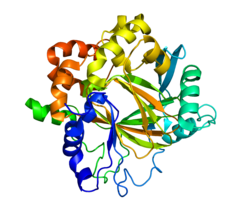KDM4D
| KDM4D | |||||||||||||||||||||||||||||||||||||||||||||||||||
|---|---|---|---|---|---|---|---|---|---|---|---|---|---|---|---|---|---|---|---|---|---|---|---|---|---|---|---|---|---|---|---|---|---|---|---|---|---|---|---|---|---|---|---|---|---|---|---|---|---|---|---|
 | |||||||||||||||||||||||||||||||||||||||||||||||||||
| |||||||||||||||||||||||||||||||||||||||||||||||||||
| Identifiers | |||||||||||||||||||||||||||||||||||||||||||||||||||
| Aliases | KDM4D, JMJD2D, lysine demethylase 4D | ||||||||||||||||||||||||||||||||||||||||||||||||||
| External IDs | OMIM: 609766; MGI: 3606484; HomoloGene: 69244; GeneCards: KDM4D; OMA:KDM4D - orthologs | ||||||||||||||||||||||||||||||||||||||||||||||||||
| |||||||||||||||||||||||||||||||||||||||||||||||||||
| |||||||||||||||||||||||||||||||||||||||||||||||||||
| |||||||||||||||||||||||||||||||||||||||||||||||||||
| |||||||||||||||||||||||||||||||||||||||||||||||||||
| |||||||||||||||||||||||||||||||||||||||||||||||||||
| Wikidata | |||||||||||||||||||||||||||||||||||||||||||||||||||
| |||||||||||||||||||||||||||||||||||||||||||||||||||
Lysine-specific demethylase 4D is an enzyme that in humans is encoded by the KDM4D gene.[5][6] KDM4D belongs to the alpha-ketoglutarate-dependent hydroxylase superfamily.
In 2017, messenger RNA from this gene was used in the somatic cell nuclear transfer experiment that produced the first two cloned primates from post-embryonic donor material.[7][8] A similar experiment was carried out to increase the cloning efficiency of bovine species in 2018.[9]
Wikinews has related news:
- Healthy cloned monkeys born in Shanghai
References
- ^ a b c GRCh38: Ensembl release 89: ENSG00000186280 – Ensembl, May 2017
- ^ a b c GRCm38: Ensembl release 89: ENSMUSG00000053914 – Ensembl, May 2017
- ^ "Human PubMed Reference:". National Center for Biotechnology Information, U.S. National Library of Medicine.
- ^ "Mouse PubMed Reference:". National Center for Biotechnology Information, U.S. National Library of Medicine.
- ^ Katoh M, Katoh M (June 2004). "Identification and characterization of JMJD2 family genes in silico". International Journal of Oncology. 24 (6): 1623–8. doi:10.3892/ijo.25.3.759. PMID 15138608.
- ^ "Entrez Gene: JMJD2D jumonji domain containing 2D".
- ^ Liu Z, Cai Y, Wang Y, Nie Y, Zhang C, Xu Y, Zhang X, Lu Y, Wang Z, Poo M, Sun Q (February 2018). "Cloning of Macaque Monkeys by Somatic Cell Nuclear Transfer". Cell. 172 (4): 881–887.e7. doi:10.1016/j.cell.2018.01.020. PMID 29395327.
- ^ Stein R (24 January 2018). "Chinese Scientists Clone Monkeys Using Method That Created Dolly The Sheep". National Public Radio. Retrieved 24 January 2018.
- ^ Liu X, Wang Y, Gao Y, Su J, Zhang J, Xing X, Zhou C, Yao K, An Q, Zhang Y (February 2018). "H3K9 demethylase KDM4E is an epigenetic regulator for bovine embryonic development and a defective factor for nuclear reprogramming". Development. 145 (4): dev158261. doi:10.1242/dev.158261. PMID 29453221.
Further reading
- Shin S, Janknecht R (August 2007). "Activation of androgen receptor by histone demethylases JMJD2A and JMJD2D". Biochemical and Biophysical Research Communications. 359 (3): 742–6. doi:10.1016/j.bbrc.2007.05.179. PMID 17555712.
- Whetstine JR, Nottke A, Lan F, Huarte M, Smolikov S, Chen Z, Spooner E, Li E, Zhang G, Colaiacovo M, Shi Y (May 2006). "Reversal of histone lysine trimethylation by the JMJD2 family of histone demethylases". Cell. 125 (3): 467–81. doi:10.1016/j.cell.2006.03.028. PMID 16603238. S2CID 14461740.
- Bonaldo MF, Lennon G, Soares MB (September 1996). "Normalization and subtraction: two approaches to facilitate gene discovery". Genome Research. 6 (9): 791–806. doi:10.1101/gr.6.9.791. PMID 8889548.




